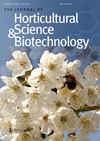Nematostatic activity of root extracts of banana (Musa spp.) genotypes as pre-infectional resistance mechanism against the burrowing nematode, Radopholus similis
IF 2.1
4区 农林科学
Q2 HORTICULTURE
Journal of Horticultural Science & Biotechnology
Pub Date : 2019-01-02
DOI:10.1080/14620316.2018.1444513
引用次数: 4
Abstract
ABSTRACTBurrowing nematode (Radapholus similis) is a major threat to banana (Musa spp.) production throughout the world. All commercial banana cultivars are lacking of R. similis resistance. The conferred resistance available in non-commercial banana genotypes opens ways to develop new hybrids with R. similis resistance by conventional or molecular-breeding techniques. Understanding the mechanism of resistance is the primary step that can provide Musa breeders and molecular biologists with the necessary principles to create nematode-resistant plants. Phenols and lignin have been ascribed as post-infectional resistant mechanism in banana. However, information on anti-nematode compounds that are presented in resistant banana plants before challenge by R. similis is limited. Therefore, the roots of some resistant/tolerant genotypes were tested for anti-nematode bioactivity by root amendment study. The root homogenates of resistant/tolerant genotypes (Yankambi km-5 (YKM-5), Pisang Lilin, Pisang Jaribuaya, Ros...香蕉(Musa spp.)基因型根提取物的抑线虫活性及其对相似穴居线虫的感染前抗性机制
Burrowing线虫(Radapholus similis)是世界各地香蕉(Musa spp.)生产的主要威胁。所有的商业香蕉品种都缺乏对相似R.similis的抗性。在非商业香蕉基因型中获得的抗性为通过常规或分子育种技术开发具有相似R.similis抗性的新杂交种开辟了途径。了解抗性机制是为穆萨育种家和分子生物学家提供创造抗线虫植物的必要原则的首要步骤。酚类和木质素被认为是香蕉感染后的抗性机制。然而,关于在R.similis攻击之前在抗性香蕉植物中存在的抗线虫化合物的信息是有限的。因此,通过根系改良研究,对一些抗性/耐受基因型的根系进行了抗线虫生物活性测试。抗性/耐受基因型(Yankambi km-5(YKM-5)、比萨丽林、比萨Jaribuaya、Ros。。。
本文章由计算机程序翻译,如有差异,请以英文原文为准。
求助全文
约1分钟内获得全文
求助全文
来源期刊
CiteScore
3.90
自引率
5.30%
发文量
67
审稿时长
3 months
期刊介绍:
The Journal of Horticultural Science and Biotechnology is an international, peer-reviewed journal, which publishes original research contributions into the production, improvement and utilisation of horticultural crops. It aims to provide scientific knowledge of interest to those engaged in scientific research and the practice of horticulture. The scope of the journal includes studies on fruit and other perennial crops, vegetables and ornamentals grown in temperate or tropical regions and their use in commercial, amenity or urban horticulture. Papers, including reviews, that give new insights into plant and crop growth, yield, quality and response to the environment, are welcome, including those arising from technological innovation and developments in crop genome sequencing and other biotechnological advances.

 求助内容:
求助内容: 应助结果提醒方式:
应助结果提醒方式:


